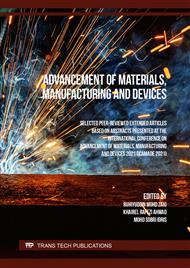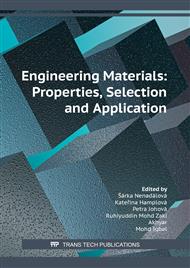[1]
M. Singh and R. Siddique, Effect of coal bottom ash as partial replacement of sand on properties of concrete,, Resources, Conservation and Recycling. (2013).
DOI: 10.1016/j.resconrec.2012.12.006
Google Scholar
[2]
E. Aprianti, P. Shafigh, S. Bahri, and J. N. Farahani, Supplementary cementitious materials origin from agricultural wastes - A review,, Construction and Building Materials. (2015).
DOI: 10.1016/j.conbuildmat.2014.10.010
Google Scholar
[3]
M. B. Ahsan and Z. Hossain, Supplemental use of rice husk ash (RHA) as a cementitious material in concrete industry,, Constr. Build. Mater., (2018).
DOI: 10.1016/j.conbuildmat.2018.05.101
Google Scholar
[4]
W. Chalee, T. Sasakul, P. Suwanmaneechot, and C. Jaturapitakkul, Utilization of rice husk-bark ash to improve the corrosion resistance of concrete under 5-year exposure in a marine environment,, Cem. Concr. Compos., (2013).
DOI: 10.1016/j.cemconcomp.2012.12.007
Google Scholar
[5]
S. Rukzon and P. Chindaprasirt, Use of rice husk-bark ash in producing self-compacting concrete,, Adv. Civ. Eng., (2014).
DOI: 10.1155/2014/429727
Google Scholar
[6]
S.M. Mahlia, Paddy residue based power generation in Malaysia: Environmental assessment using LCA approach,, ARPN J. Eng. Appl. Sci., (2015).
Google Scholar
[7]
Y. Zou and T. Yang, Rice husk, rice husk ash and their applications,, in Rice Bran and Rice Bran Oil: Chemistry, Processing and Utilization, (2019).
DOI: 10.1016/b978-0-12-812828-2.00009-3
Google Scholar
[8]
M. F. M. Zain, M. N. Islam, F. Mahmud, and M. Jamil, Production of rice husk ash for use in concrete as a supplementary cementitious material,, Constr. Build. Mater., (2011).
DOI: 10.1016/j.conbuildmat.2010.07.003
Google Scholar
[9]
M. A. Azmi, N. A. A. Ismail, M. Rizamarhaiza, A. A. K. W. M. Hasif, and H. Taib, Characterization of silica derived from rice husk (Muar, Johor, Malaysia) decomposition at different temperatures,, (2016).
DOI: 10.1063/1.4958748
Google Scholar
[10]
K. Kartini, H. B. Mahmud, and M. S. Hamidah, Absorption and permeability performance of selangor rice husk ash blended grade 30 concrete,, J. Eng. Sci. Technol., (2010).
Google Scholar
[11]
R. S. Bie, X. F. Song, Q. Q. Liu, X. Y. Ji, and P. Chen, Studies on effects of burning conditions and rice husk ash (RHA) blending amount on the mechanical behavior of cement,, Cem. Concr. Compos., (2015).
DOI: 10.1016/j.cemconcomp.2014.09.008
Google Scholar
[12]
S. Muthukrishnan, S. Gupta, and H. W. Kua, Application of rice husk biochar and thermally treated low silica rice husk ash to improve physical properties of cement mortar,, Theor. Appl. Fract. Mech., (2019).
DOI: 10.1016/j.tafmec.2019.102376
Google Scholar
[13]
- Sasui, W. Jinwuth, and S. Hengrasmee, The Effects of Raw Rice Husk and Rice Husk Ash on the Strength and Durability of Adobe Bricks,, Civ. Eng. J., (2018).
DOI: 10.28991/cej-0309128
Google Scholar
[14]
W. Schmidt, N. S. Msinjili, and H. C. Kühne, Materials and technology solutions to tackle the challenges in daily concrete construction for housing and infrastructure in sub-Saharan Africa,, African J. Sci. Technol. Innov. Dev., (2019).
DOI: 10.1080/20421338.2017.1380582
Google Scholar
[15]
C. Fapohunda, B. Akinbile, and A. Shittu, Structure and properties of mortar and concrete with rice husk ash as partial replacement of ordinary Portland cement – A review,, International Journal of Sustainable Built Environment. (2017).
DOI: 10.1016/j.ijsbe.2017.07.004
Google Scholar
[16]
M. Thiedeitz, W. Schmidt, M. Härder, and T. Kränkel, Performance of rice husk ash as supplementary cementitious material after production in the field and in the lab,, Materials (Basel)., (2020).
DOI: 10.3390/ma13194319
Google Scholar
[17]
S. Chandrasekhar, P. N. Pramada, and J. Majeed, Effect of calcination temperature and heating rate on the optical properties and reactivity of rice husk ash,, J. Mater. Sci., (2006).
DOI: 10.1007/s10853-006-0859-0
Google Scholar
[18]
W. Xu, T. Y. Lo, and S. A. Memon, Microstructure and reactivity of rich husk ash,, Constr. Build. Mater., (2012).
Google Scholar



